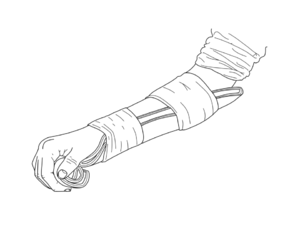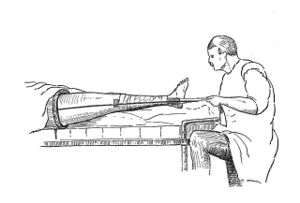Splinting: Difference between revisions
No edit summary |
No edit summary |
||
| Line 7: | Line 7: | ||
'''Top Contributors''' - {{Special:Contributors/{{Splint}}}} | '''Top Contributors''' - {{Special:Contributors/{{Splint}}}} | ||
</div> | </div> | ||
== | == Definition == | ||
A splint is a rigid or flexible device that maintains in position a displaced or movable part, also used to keep in place and protect an injured part<ref>VanBlarcom CW, editor. [https://www.thejpd.org/article/S0022-3913(99)70234-9/fulltext The glossary of prosthodontic terms]. Mosby; 1999.</ref> to support healing, and to prevent further damage<ref>Althoff AD, Reeves RA. [https://www.ncbi.nlm.nih.gov/books/NBK557673/ Splinting]. StatPearls [Internet]. 2020 May 24.</ref>. | A splint is a rigid or flexible device that maintains in position a displaced or movable part, also used to keep in place and protect an injured part<ref>VanBlarcom CW, editor. [https://www.thejpd.org/article/S0022-3913(99)70234-9/fulltext The glossary of prosthodontic terms]. Mosby; 1999.</ref> to support healing, and to prevent further damage<ref>Althoff AD, Reeves RA. [https://www.ncbi.nlm.nih.gov/books/NBK557673/ Splinting]. StatPearls [Internet]. 2020 May 24.</ref>. | ||
[[File:Arm splint.png|alt=Image showing arm splint|center|thumb|Arm splint]] | [[File:Arm splint.png|alt=Image showing arm splint|center|thumb|Arm splint]] | ||
| Line 24: | Line 24: | ||
== Different Types of Splints == | == Different Types of Splints == | ||
Splints for upper limbs<ref name=":0">Boyd AS, Benjamin HJ, Asplund CA. [https://www.researchgate.net/publication/26784832_Splints_and_Casts_Indications_and_Methods Splints and casts: indications and methods]. American family physician. 2009 Sep 1;80(5):491-9.</ref> | |||
==== Splints for upper limbs<ref name=":0">Boyd AS, Benjamin HJ, Asplund CA. [https://www.researchgate.net/publication/26784832_Splints_and_Casts_Indications_and_Methods Splints and casts: indications and methods]. American family physician. 2009 Sep 1;80(5):491-9.</ref> ==== | |||
{| class="wikitable" | {| class="wikitable" | ||
!Region | !Region | ||
| Line 59: | Line 60: | ||
* Double sugar-tong splint | * Double sugar-tong splint | ||
|} | |} | ||
== References == | == References == | ||
<references /> | <references /> | ||
[[Category:Interventions]] | [[Category:Interventions]] | ||
Revision as of 18:07, 28 October 2020
This article is currently under construction and may only be partially complete. Please come back soon to see the finished work. Thank you! (28/10/2020)
Original Editor - Shwe Shwe U Marma
Top Contributors - {{Special:Contributors/Template:Splint}}
Definition[edit | edit source]
A splint is a rigid or flexible device that maintains in position a displaced or movable part, also used to keep in place and protect an injured part[1] to support healing, and to prevent further damage[2].
Purpose of Splinting[edit | edit source]
- Immobilization
- Support to promote healing
- Positioning or supporting during function
- Pain relief[3]
- Correction and prevention of deformity[4]
- Restoring or maintaining of range of motion[5]
- Oedema control[6]
Different Types of Splints[edit | edit source]
Splints for upper limbs[3][edit | edit source]
| Region | Type of splint |
|---|---|
| Ulnar side of hand | Ulnar gutter splint |
| Radial side of hand | Radial gutter splint |
| Thumb, first metacarpal, and carpal bones | Thumb spica splint |
| Finger injuries |
|
| Wrist/hand |
|
| Forearm | Single sugar-tong splint |
| Elbow, proximal forearm, and skeletally immature wrist injuries |
|
References[edit | edit source]
- ↑ VanBlarcom CW, editor. The glossary of prosthodontic terms. Mosby; 1999.
- ↑ Althoff AD, Reeves RA. Splinting. StatPearls [Internet]. 2020 May 24.
- ↑ 3.0 3.1 Boyd AS, Benjamin HJ, Asplund CA. Splints and casts: indications and methods. American family physician. 2009 Sep 1;80(5):491-9.
- ↑ Singh KA, Shah H, Joseph B. Comparison of plaster-of-Paris casts and Woodcast splints for immobilization of the limb during serial manipulation and casting for idiopathic clubfoot in infants: a prospective randomized trial. The Bone & Joint Journal. 2020 Oct 3;102(10):1399-404.
- ↑ Rezaei B, Mahdavinejad R. Massage therapy and Splint in males with Carpal Tunnel syndrome. Journal of Advanced Pharmacy Education & Research| Jan-Mar. 2020;10(S1).
- ↑ Giang TA, Ong AW, Krishnamurthy K, Fong KN. Rehabilitation interventions for poststroke hand oedema: a systematic review. Hong Kong Journal of Occupational Therapy. 2016 Jun 1;27:7-17.








